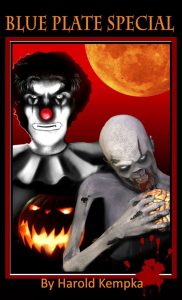 Jonathan Maberry, a wise author and mentor, once told me that the best way to get readers is not by pushing your book but by “branding” yourself. Perhaps you have a favorite shirt you might wear to signings. Perhaps everything you live and breathe resonates with Star Trek. I’ve been doing mine via Mylar balloons. Why balloons? I can’t say why, but I find it impossible to shop at most supermarkets without being waylaid by the balloons at the floral aisle. How many balloons do I have? A lot. If you’d like to guess how many, there’s a giveaway involved.
Jonathan Maberry, a wise author and mentor, once told me that the best way to get readers is not by pushing your book but by “branding” yourself. Perhaps you have a favorite shirt you might wear to signings. Perhaps everything you live and breathe resonates with Star Trek. I’ve been doing mine via Mylar balloons. Why balloons? I can’t say why, but I find it impossible to shop at most supermarkets without being waylaid by the balloons at the floral aisle. How many balloons do I have? A lot. If you’d like to guess how many, there’s a giveaway involved.
 Any time you blog or go to a writing venue you’re “on,” meaning that the way you carry yourself will become part of your brand. So whenever you blog, you’ll want to keep it positive. If you had a quarrel at home, leave it there. Give yourself plenty of time to get to an event because if you show up late, people might associate lateness with your brand. “Oh, yeah, that’s Barbara of the Balloons – she takes her time,” and so forth. When I’m with writer buddies, doing the editor letter for Night to Dawn, or blogging, I usually open the top with my latest balloon escapade at the Giant, Acme, or other market. And I find that balloon analogies have a way of getting the point across.
Any time you blog or go to a writing venue you’re “on,” meaning that the way you carry yourself will become part of your brand. So whenever you blog, you’ll want to keep it positive. If you had a quarrel at home, leave it there. Give yourself plenty of time to get to an event because if you show up late, people might associate lateness with your brand. “Oh, yeah, that’s Barbara of the Balloons – she takes her time,” and so forth. When I’m with writer buddies, doing the editor letter for Night to Dawn, or blogging, I usually open the top with my latest balloon escapade at the Giant, Acme, or other market. And I find that balloon analogies have a way of getting the point across.
 Sometimes your brand can creep into your books. NTD author Michael De Stefano, for one, loves baseball, and you’ll find a lot of scenes involving baseball in In the Times of Their Restlessness and his other two books. Tom Johnson’s bouquet of balloons is his life in the military, and his experiences and love of science fiction creep into his Jur novels. Rod Marsden brands himself with his love of history in Ghost Dance, among his other books.
Sometimes your brand can creep into your books. NTD author Michael De Stefano, for one, loves baseball, and you’ll find a lot of scenes involving baseball in In the Times of Their Restlessness and his other two books. Tom Johnson’s bouquet of balloons is his life in the military, and his experiences and love of science fiction creep into his Jur novels. Rod Marsden brands himself with his love of history in Ghost Dance, among his other books.
So … I guess you’re wondering if Mylar balloons have crept into my books. Well, let me put it to you this way. Did God make little green apples? Does it snow in Pennsylvania during the wintertime? Heroine Alexis of Steel Rose kept a squadron of Mylar balloons in her hospital room because she felt that the helium in them, being especially poisonous for Kryszka aliens, might protect her from the renegades. You will also meet balloon queens in Close Liaisons and City of Brotherly Death.
The most important part of branding though is having fun. Why is it so important? Because the branding tool enables people to get to know you in a good way. When that happens, good reviews, if not sales, are likely to follow.
So … how do you go about branding yourself and your work? Do you have a special interest in something that works? I’d love to hear about your experiences.
I’m offering two giveaways: A signed copy of Steel Rose and a copy of Night to Dawn 28, to be given to a random commenter during this blog hop. And if you can guess how many Mylar balloons I have, the person with the closest guess will get an eBook copy of Close Liaisons and City of Brotherly Death.













